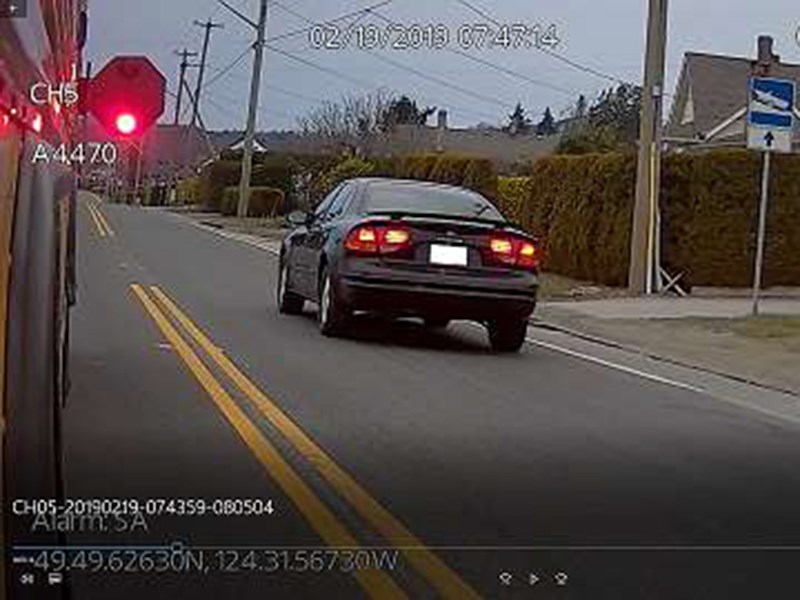Now that school is back, drivers are reminded that rules of the road require stopping for school buses when signs and flashing lights are activated.
School District 47 transportation manager Shaun Garvey said people ignoring the signs and lights is a problem.
“That has been an issue that was flagged fairly early on with me working with the school district,” said Garvey. “We made it a top priority early on last year to come up with some strategies to deal with that situation, the first of which was to install exterior video cameras on all of our regular buses.
“Those cameras have been running since mid-December of 2018. They are designed to pick the approaching and following vehicles whenever our buses are preparing to stop, or the pickup or disembarking of students.”
Garvey said the cameras have been working well as a tool to provide the school district with information about the general public not following the rules, and providing the school district with the opportunity to supply RCMP with evidence packages that can be used to issue violation tickets to offenders.
Violations happen regularly. On any given week, Garvey said he typically receives three to five reports. There are nine buses on the road equipped with these cameras. Drivers fill out an incident report relative to the time of the infraction, as well as the date and location, plus the vehicle involved, which allows Garvey to go into the video system and pull out the appropriate video clips to support the incident report.
“We end up with up to five a week and I find about 80 per cent of those are clear-cut that the stop arm was deployed with plenty of time for the typically approaching vehicle to have stopped well in advance of the bus,” said Garvey. “Anything that is really close, typically I won’t send to the RCMP, with the exception of those where either a student is put at significant risk, or if a commercial vehicle is involved, because they should have a higher understanding of standard of care and public safety.”
Garvey said the first thing drivers should be looking for is the school bus itself. He said there are not too many places along the routes where buses are not very visible. The buses, when stopping, deploy the yellow flashing caution lights typically, as per the Motor Vehicle Act, 10 seconds in advance of deploying the red lights.
“Much like any intersection, the yellow caution light is supposed to signal approach with caution and slow appropriately, because something is going to happen,” said Garvey. That seems to be something a lot of drivers miss.
“And then, drivers should be looking for the stop arm itself, which is then deployed and will sometimes will be deployed for a few seconds to allow children to be picked up or disembark, or even longer, depending on how many students we have getting off at the stop.”
The worst locations for violations are on the highway, said Garvey. There are two buses that travel north of town and two buses that travel south of town and it’s from those buses that most reports are generated.
“People should be very aware that the Motor Vehicle Act regulations are very specific that vehicles are stopped, regardless of which direction they are travelling, when they see the red stop arm deployed,” said Garvey.
He said the school district is concentrating on raising awareness about the rules of the road, relating to school buses, to protect students and the school district’s equipment.
“I can’t stress enough that a little life or more than one life could be at stake here,” said Garvey. “Nobody should be in as much of a rush or not aware of what is going on around them when it comes to a school bus. There’s a lot of exposure out there on the road.”
Garvey reinforced that it is important for motorists to leave enforcement of violations to the school district and RCMP. He said he does not want people to take matters into their own hands and become vigilantes. Last year, there was an incident where a driver observed an infraction and pulled out into the oncoming lane to block the oncoming vehicle.
“It was a very close call between vehicles on the highway travelling at highway speeds,” said Garvey. “It’s not up to people to take matters into their own hands. Please let us deal with this in our own way.”
Powell River RCMP constable Chris Bakker indicated the rules for school buses are clear cut.
Bakker said section 149 of the Motor Vehicle Act states:
The driver of a vehicle on a highway, on meeting or overtaking a school bus (a) that is designated as a school bus, (b) that is stopped on a highway, and (c) on or near which a sign or signal is displayed indicating the school bus is receiving or discharging school children, must stop the vehicle before reaching the bus and not proceed until the bus resumes motion or the driver of the bus signals to the other drivers that it is safe to proceed.
Bakker said the offence is failing to stop for a school bus, contrary to section 149 of the Motor Vehicle Act, which is subject to a $368 fine and three points.
“Since January 1, 2018, the Powell River RCMP have received 46 calls for service involving vehicles speeding by or passing school buses,” said Bakker. “In most of these instances the school buses were stopped to pick up kids with the stop signs out and the flashing lights on. Of the 46 calls for service, a significant number of drivers received violation tickets as a result.”



